This was published 7 years ago
How food is prepared by airlines, cruise ships, trains and hotels to feed thousands of guests
Talk about food miles. Twenty four hours a day, 365 days a year, thousands of meals are served to passengers in the air, at sea or on the rails. The demand is unwavering, the safety and presentation standards high and the request for special meals grows.
Traveller writers go behind the scenes of an airline, cruise ship, rail line and hotel to discover what it takes for your perfect mojito, rack of mezze plate or crocodile sausage to arrive at your table, perfectly prepared.
THE AIRLINE: EMIRATES
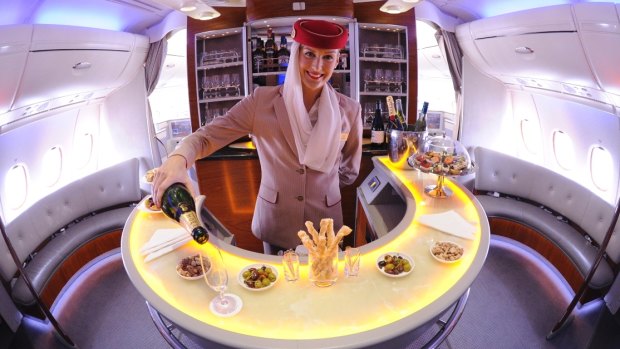
Cabin crew serve champagne in the onboard lounge on an Emirates A380.
By Sue Bennett
It began with breakfast service on a flight out of Sydney and today it's become known as "Croissant-gate". Joost Heymeijer, responsible for everything that goes on board Emirates flights from the headsets to the blankets and menus, wanted to know why a pastry that should be buttery, flaky and full-of-air, was "crushed and inedible" when served.
His interrogation of mid-air croissant procedures put staff on notice. Emirates airline's new senior vice-president in charge of catering service delivery would take a long, hard look at how things were done. In the case of the much maligned croissant, he was told: "We've always done it that way."
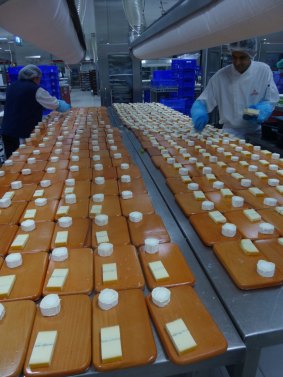
Behind the scenes preparation of food at the Emirates Flight Catering facility in Dubai.Credit: Sorrel Kesby
Heymeijer, a former food and beverage manager at the Hilton Sydney, was swapping his workplace from the glorious natural beauty of the Australian bush in Wolgan Valley in the Blue Mountains, where he was resort general manager for five years, to live in urbanised, often blisteringly hot, Dubai.
Today, he oversees a test kitchen where new dishes are created and tested for an airline serving more than 1500 different menus annually (including 17 million croissants annually). From its two Dubai catering units, Emirates Flight Catering (EKFC) creates almost 50 million meals for its planes, and eight million for other airlines, each year.
Combined, the two units make up an impressive facility. They span 88,000 square metres and feature high-level automation, including a 2.55 kilometre-long electric monorail which transports meal carts, and a conveyor system for transferring clean items from the equipment cleaning area to the production kitchen for food plating and then on to the operational areas for flight packing.
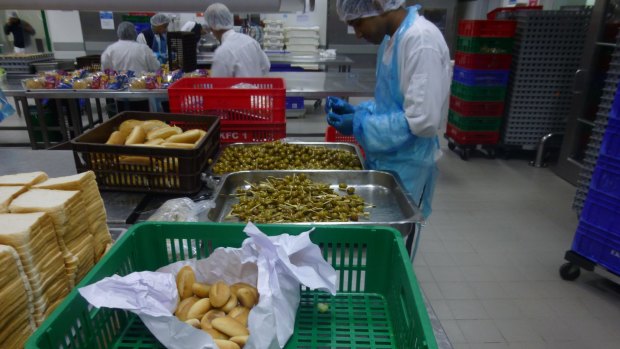
Behind the scenes preparation of food at the Emirates Flight Catering facility in Dubai.Credit: Sorrel Kesby
The facilities also feature a vacuum waste system with pipes over 600 metres in length. Both facilities feature the latest systems in hygiene, energy saving and automated food production equipment.
The technologically advanced catering facility, EKFC1, is dedicated to the flights of Emirates, servicing an average of 236 Emirates departures daily on one of the world's youngest aircraft fleets.
The EKFC2 facility services all other airlines landing and departing from Dubai International Airport and Al Maktoum International Airport, including the low-cost airline flydubai and 128 additional airline customers. In addition to legacy commercial carriers, EKFC2 services private aviation and VIP flights. EKFC2 also provides food and beverage services to most airline hospitality lounges at Dubai International Airport's concourses, including Emirates' own lounges.
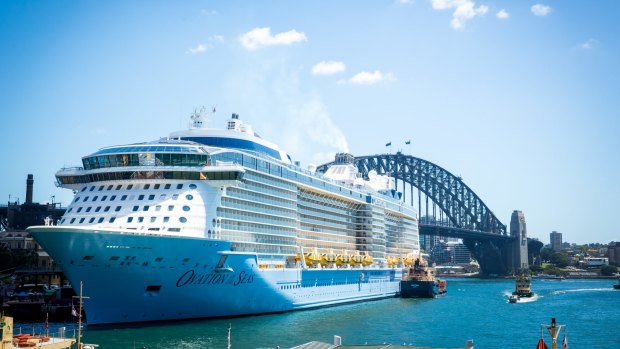
Ovation of the Seas: The daily challenge is to feed as many as 20,000 meals to 4500 or more passengers, not to mention a sea-going workforce of about 1600.Credit: Anna Kucera
With a daily production of 500,000 bakery items, a daily protein and vegetable turnover of 20,000 kilograms each, a new bakery and commissary sections at EKFC2 are on-track to be the largest of their kind under the same roof.
It takes 10,000 staff of 52 different nationalities – including chefs experienced in every culinary tradition, from sushi for Japanese routes to regional curries for flights to the Indian sub-continent and every cuisine in between – to satisfy the tastes of the airline's multinational passengers.
Heymeijer, and colleague senior operational performance manager Jane Marie Zdrojewski, are perfectly placed to put fact and fiction about airline food to the test. One particular challenge is special diets with the International Transport Association (IATA) identifying 20 that need to be serviced by airlines. The least requested on Emirates, which serves them all, is the Indian religion Jain while vegetarian is now so mainstream it's served as the second choice on all flights.
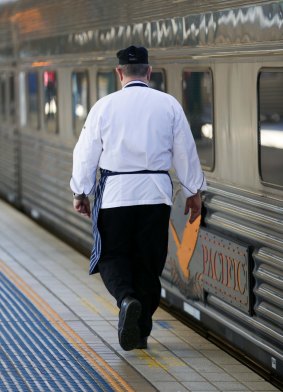
The chef is responsible for feeding passengers travelling between Darwin and Adelaide on The Ghan.
But what about allergies to foodstuff such as peanuts? "This is the only one we cannot do," says Zdrojewski. "We know what we do here [in its catering units] but we cannot guarantee what our suppliers do."
Not happy with your inflight meal? Heymeijer and Zdrojewski say it's definitely worth complaining. Airline crew are equipped with laptops to enter passenger comments with Heymeijer's team reviewing them every 24 hours. If the same report appears more than 10 times in a month, it's a trend and the dish is reviewed. Fast. One dish that never comes off the menu is its signature inflight mezze plate.
For economy class flyers Emirates makes all its food, from bread to tempered chocolate for desserts. IATA stipulates no more than 48 hours ahead for cold dishes and 72 hours for hot ones from preparation to consumption. Emirates averages 10-12 hours for cold, 12-16 hours for hot and often much less. "It's very much a just-in-time operation," says Zdrojewski. "That helps control wastage."
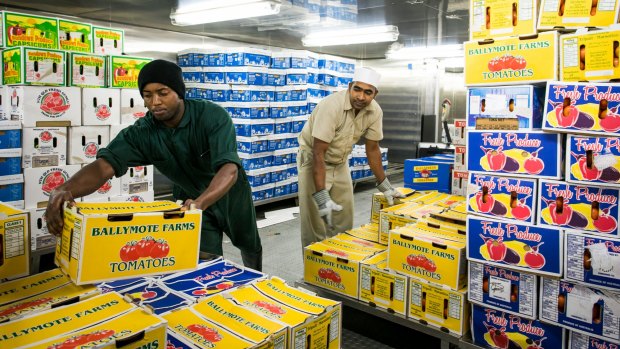
Food is unloaded into the huge fridges on board Ovation of the Seas cruise ship.Credit: Anna Kucera
The Dubai kitchens make about 180,000 meals daily and employ 10,000 people. Record days far exceed 200,000 meals. Ingredients are sourced from more than 50 countries with a small amount, including fresh fish, fruit and vegetables, from the United Arab Emirates. Brazil and Australia are among the biggest suppliers.
If it's the Californian strawberry season, the fruits are flown from the US while 1000 kilograms of pineapples are used daily rising to 3500 kilograms during Ramadan.
Strict food-safety rules are followed at every step. Each 24-hour cycle is broken into quarters and all food is colour coded to indicate when it's made. At midnight every day, all fridges are cleared and a new cycle begins. Heating times, cooling times, blast freezing and fridge temperatures are meticulously controlled.
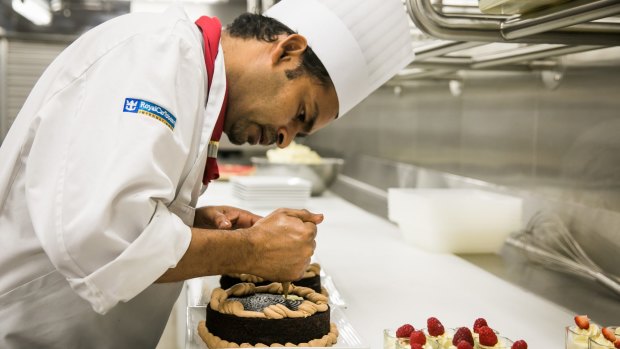
Chefs preparing food in the kitchens on board Ovation of the Seas cruise ship.Credit: Anna Kucera
All equipment, like glasses and cutlery, is loaded first. A block of dry ice put in top of each food trolley and on board, they go into refrigerated compartments. The size of ice block is important or the contents freeze. When it comes to preparing the food once in flight, it takes about 25 to 30 minutes to heat.
The food for a flight arrives on board within two hours of departure and, for security, everyone connected with food delivery needs to be off a plane before the final hour. At a NASA-style control room in the catering facility, staff monitor flights and catering deliveries with giant electronic boards showing colour-coded plane-shaped symbols parked at terminals.
"If a plane is blue, a job is allocated, if it's brown it's waiting for a job allocation," says Zdrojewski. "If the plane is fat, it's an A380. If it's fat and it's red, it's on the one-hour countdown. You want everyone off a plane that's red or you want to know why someone is still on there. You can click on any plane and it will tell you what it's doing and who is on it."
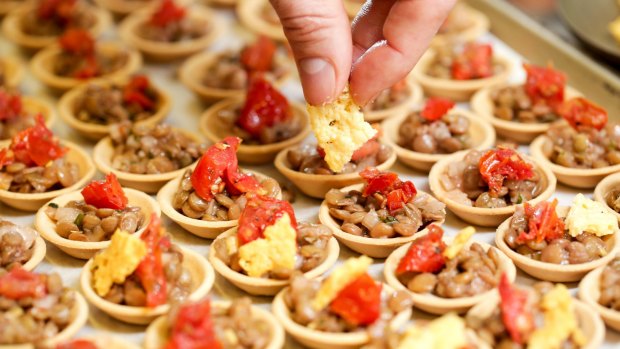
Chef preparing canapes.
So, what happened to the much maligned croissant?
"I asked why are they heated because that's where they lose all their structure. If you buy a croissant in France, it's not hot so why do we do it?" says Heymeijer.
Suffice to say, croissants should now be served room, or cabin, temperature.
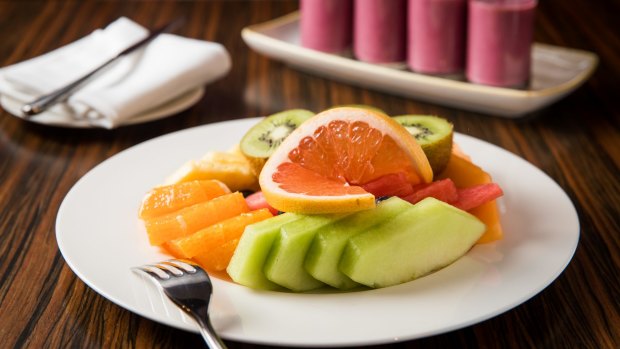
Seasonal fruit platter and breakfast smoothies at The Sailmaker restaurant at Hyatt Regency Hotel in Darling Harbour.Credit: Anna Kucera
Sue Bennett travelled to Dubai and visited Flight Catering as a guest of Emirates. See emirates.com
THE LIST
SIZE OF DUBAI CATERING CENTRE 56,000 square metres
EMIRATES DEPARTURES DAILY 236
MEALS SERVED DAILY 180,000
MEALS SERVED ANNUALLY 58 million
PASSENGERS CARRIED ANNUALLY 55 million
BAKERY ITEMS SERVED DAILY 500,000
CATERING STAFF 10,000
NUMBER OF NATIONALITIES 52
ADDITIONAL AIRLINE CLIENTS 128
See also: Airline review: Emirates business class
See also: Emirates unveils new, larger 'saloon' bars on board its A380 superjumbos
THE SHIP: OVATION OF THE SEA
By Anthony Dennis
Take a typical town totalling 6100 or so people. Then try and consider just how to feed, water and supply them all daily. Once you've done that, set them adrift hundreds or more nautical miles out to sea for 10 or 14 days, or even longer.
Congratulations. You've now got a rough idea of what it takes to operate Royal Caribbean's mammoth Ovation of the Seas, the world's fourth largest cruise passenger ship, which now calls Sydney its annual base for the summer cruise season.
The daily challenge to feed as many as 20,000 meals to 4500 or more passengers, not to mention a sea-going workforce of about 1600, aboard such a huge vessel, across eight speciality restaurants with over 150 different dishes, is near Herculean. On a typical seven-day cruise, passengers can choose from more than 40 types of bread, 100 kinds of pastries, 40 different types of fruits and 80 kinds of vegetables.
To keep passengers fed and happy, nearly 250 culinary staff need to toil in windowless and spotless state-of-the-art galleys (it's not a kitchen – this is a ship, after all) below the main decks far removed from the holidaying passengers. And that's just what's required for the preparation and delivery of the food, not to mention the complications posed by modern-day, first world dietary and allergy requirements.
Food is one thing but what about that timeless cruise staple, the cocktail: 272 kilograms of limes, 340 kilograms of lemons, 1360 kilograms of pineapple, 1700 kilograms of oranges, 30 jars of cherries, 15 jars of olives... The list goes on (and on) and don't even ask how many of those funny little umbrellas might be required, though, at more than 180 beverage staff, the ship needs nearly as much personnel to for drinks as it does food. No wonder Ovation of the Seas features a special robotic barman.
Once cruising was a pastime dominated by Americans and a handful of other Western nations but it is now a truly global pursuit with countries such as China embracing the idea of a holiday on the high seas. Menus need to be tailored accordingly, no less for Australians, now boasting the highest cruise market penetration per capita of any nation.
"The expectations of Australian guests are very high," says Daniel Ledo Trujillo, Ovation of the Seas Madrid-born executive chef. "They are tough guests to please."
By that, he doesn't mean we complain a lot, or any more than anyone else. It's just that, coming from a multicultural society and being increasingly well-travelled compared with previous generations, we're exposed to a multitude of cuisines.
It's making us much more knowing and demanding. But some old favourites remain. Something that distinguishes the Australian cruising palate from other nationalities is a love of lamb which means that any voyage involving Australians needs to be well-stocked with this meaty staple.
And if an army is said to march on its stomach then a ship sails on one, too, with food an increasingly integral part of the cruise experience. That means that Trujillo and his team are always sure to prepare more food than they need, as you can never judge the exact appetite of the passengers on each cruise.
At sea, the executive chef's days are long, beginning as early as 7.30am and not finishing until 10pm or so, though the 35-year-old Spaniard does manage to sneak away for a well-deserved siesta in the middle of the day.
Anthony Dennis cruised aboard the Ovation of the Seas as a guest of Royal Caribbean. See royalcaribbean.com.au
THE LIST*
CHICKEN 3300 kilograms
EGGS 3750 dozen
BEEF 5100 kilograms
ICE CREAM 238 kilograms
BAKING POTATOES 6803 kilograms
FLOUR 4286 kilograms
BACON 1803 kilograms
FRENCH FRIES 1700 kilograms
BREAD 40 types
PASTRIES 100 varieties
SALMON 850 kilograms
LOBSTER TAILS 714 kilograms
*Typical supplies needed for a seven-day cruise
See also: On board the billion-dollar Ovation of the Seas
THE PASSENGER TRAIN: THE GHAN
By John Huxley
Bring me a crocodile sausage … and make it snappy! It sounds like a line from an ancient Marx Brothers movie. But it is, in fact, a most reasonable request for platinum-class passengers travelling between Darwin and Adelaide on The Ghan. As the train's senior "Chef de Partie" Joseph Cobiac, who devised the dish and many others, explains in the day's menu notes, the crocodile has "long been a Northern Territory bushfood".
Served as boudin blanc (white sausage), on potato puree with a lemon aspen sauce and sea blite, it makes an appetising and, as important, appropriate entree for guests making the historic 2949-kilometre journey through central Australia. "We try whenever possible to devise and serve food which is 'of the place' – of the countryside we travel through. Meals which have a history behind them, which have a small story to share with our guests."
Menus for the luxury four-day, three-night adventure provide daily confirmations of the chef's policy. They include saltwater barramundi – a name derived from an Aboriginal word meaning "large-scaled silver fish", served with fennel puree, baby spinach and lemon oil.
Panang-style, mild buffalo curry, in recognition of the beefy-tasting meat from an animal first introduced to northern Australia in the 1820s. And apricots, which recall the enjoyment of the fruit, fresh or dried, by the Afghan or "Ghan", camel caravaners who worked in outback Australia from the 1860s.
Devising, and sourcing new and old favourites, is only part of the daily miracle of providing three meals, for up to four days, to more than 300 hungry guests – taking the great train up and down, back and forth across Australia.
"I really wouldn't want to be doing anything else," says Cobiac, who has worked on the Great Southern Railway for more than 20 years, devising menus, trying, testing dishes, ordering food deliveries and organising staff.
"It's a dream job," he says, cheerfully revealing that on days off he happily cooks meals for him and his wife. "I can't help myself. I just love cooking," he says, adding that some new dishes undergo six months of trials before being passed food fit for The Ghan.
Some ingredients, some side-dishes – such as small, complicated, time-consuming juices and dressings, for example – may be mixed "back at base" and carried on board. But most of the food must, for freshness-sake, be prepared and cooked on the train. It is no easy task. The train ride can be surprisingly bumpy in places, the kitchens of "limited cat-swinging dimensions" and the daily rush to prepare "special requirement" and instant "a la carte" orders challenging.
"So, this is where it all happens," says our on-board chef Sam Markham, emerging, it seems, from a giant refrigerator, proudly unveiling trays of 500 newly made canapes for instant consumption. A friendly, unflappable man, whose wife Laura also works on the train, knows the importance of forward planning.
Markham's kitchen, which he shares with two other staff, Liz and Tim, is half a carriage long, and one of three on the 912 metre-long train. Each contains two stand-up fridges and a larger cool room, a flat top grill, two electric ovens and a six-burner electric top.
Markham and his on-board cooking team of 12 can work anything up to 17 hours on days when they must cater for all three meals. Every trip they have one evening off, when dinner is eaten off the train, at the historic Alice Springs Telegraph Station Historical Reserve.
Here, guests enjoy a scrumptious, outdoor barbecue, prepared by local cooks, under a panoply of twinkling stars. It finishes late. Back on planet Earth, Sam has just a few more hours' sleep before he must wake and prepare next day's brunch.
The writer travelled as a guest of Tourism NT and The Ghan. See greatsouthernrail.com.au
THE LIST*
BREAD 198 loaves
MILK 240 x 2 litre containers
EGGS 300 cartons
ORANGE JUICE 240 litres
STEAK 40kg
BARRAMUNDI 50 kilograms
BROCCOLINI 185 bunches
TOMATOES 69 kilograms
LEMON MERINGUES 352
LEMONS 16 kilograms
ORANGES 11 kilograms
PINEAPPLES 13
ROCK MELONS 11
CHEESE 60 blocks
*Typical supplies needed per journey
See also: On board the Ghan's 2979-km journey through Australia's heart
THE HOTEL: HYATT REGENCY SYDNEY
By Nina Karnikowski
It's easy to imagine that Robert Sauer could be among the most stressed workers in Australia. As executive chef of Australia's largest hotel, Sydney's Hyatt Regency, which just months ago opened its doors in Darling Harbour after a $250 million redevelopment, on any given day Sauer could be feeding 3000 people.
That's not just guests staying in the hotel's 892 rooms, but also street trade and those filling the 21 meeting rooms and two ballrooms, the lobby lounge and the recently opened rooftop Zephyr bar. "On a busy day, we'll go through a quarter of a tonne of fish, and the same amount of meat," says Sauer, gazing out over the glittering waters of Darling Harbour from his perch in the hotel's 300-seat Sailmaker restaurant. "As for fruit and vegies? It's more like one tonne, which fits into two or three semi-trailers that come in throughout the day."
Parlaying this absurd amount of food into thousands of meals worthy of the Hyatt brand every day is a mind-bending job, right? The mere thought of it might make an ordinary mortal hide under the bed covers to avoid dealing with it all. But not Sauer. No, he gets out from under those covers six mornings a week for a 7am start, taking the Hyatt's whopping provisioning operations in his stride.
Which really aren't that whopping to him anyway. Until a year ago, he was overseeing the preparation of 13,000 meals everyday on board the Celebrity Solstice cruise ship, where he was executive chef for five years. This culinary saga starts from 3am each day, when Sauer's breakfast team arrives to prepare the 5.30am breakfast buffet. Soon the food trucks start to arrive, which are dealt with by what Sauer calls the "store keepers," who take the food to an underground storage area of the 15-floor hotel. That food is then filtered upstairs into the kitchen's cool rooms throughout the day as it's needed.
It sounds easy enough. Until you start to think about how on earth, with all those tonnes of food coming in and moving around and going out plated up to discerning guests, the culinary team ensures that every single item is fresh and safe to consume. "That would be the strictest part of the operation, the food-safety element and the hazard control systems," says Sauer.
Indeed, from the moment food is delivered to the Hyatt's loading dock it is tracked, inspected and documented by Sauer's team of 80 chefs. The core temperature is taken before each item even enters the Hyatt, and is then documented again before it's cooked, when it's cooked, when it's cooled, when it's reheated, and when it goes out to the guest. Cross-contamination is also prevented by keeping storage, preparation and cooking in separate rooms, down in the relatively compact 185-square-metre chrome-filled kitchen.
Predicting guests' tastes is another challenge for Sauer and his team. For his first six months at the Hyatt, Sauer did nothing but research and design his menus, visiting all the key hotels and restaurants in Sydney, and also travelling to the US and Europe, to get a snapshot of what was happening on the culinary scene. All that work, and the menus then need to be rewritten each season, to keep up-to-date with the seasonal produce that's available locally.
Each morning Sauer and his team look at the nationality and age breakdown of the guests, then organise the quantities and varieties of dishes to make sure they have the right mix. This is especially important on the breakfast buffet, which is one of the largest in Sydney offering about 60 varieties of food from all over the world, and which feeds up to 900 guests each morning.
The biggest hurdle Sauer faces today, though, is the increasing number of dietary requirements. "It's a huge undertaking. You'll have a function for 800, and 50 of those meals have to be modified in 50 different ways." The Hyatt even employs a special dietary chef to deal with all these requirements – from kosher and halal, to vegan, gluten-free and paleo, to no lactose, sugar, salt, nuts or deadly nightshades.
It's a tough gig, but Sauer will keep getting out from under those covers each morning to do it because, well, he loves it. "When all the function rooms are firing it's so exciting. And to see the full culinary team at work makes the months of planning and sourcing just the right ingredients pay off."
THE LIST*
BREAD 568 loaves
MILK 636 x 2 litre
EGGS 31 cartons
ORANGE JUICE 689 litres
BARRAMUNDI 69 pieces
BROCCOLINI 10 bunches
TOMATOES 280 kilograms
LEMONS 54 kilograms
ORANGES 109 kilograms
PINEAPPLES 27 cases
ROCKMELONS 19 cases
*Typical Weekly Supplies
See also: Hyatt Regency Sydney, Australia's largest hotel, opens
Sign up for the Traveller Deals newsletter
Get exclusive travel deals delivered straight to your inbox. Sign up now.